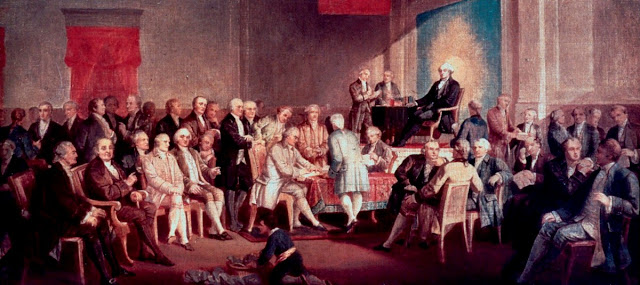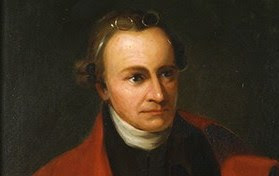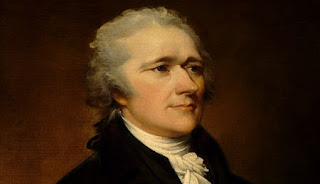
The drafted Constitution was submitted to the Congress of the Confederation in September 1787. In the same month it approved the forwarding of the U.S. Constitution as drafted to the states, each of which would hold a ratification convention. The Congress of the Confederation directed to held election, when in September 1788, the Congress certified that eleven states had ratified the new Constitution. The new government began on March 4, 1789, assembled in New York City. Establishing protections for various civil liberties, the states ratified the Bill of Rights in 1791.
Radical leaders either had failed to be elected or like Patrick Henry refused to participate. As the minister to France, Jefferson was out of the country. Among more conservative statesmen the only outstanding figures who were absent were John Adams (who was envoy to Great Britain) and John Jay (who was still Secretary of Foreign Affairs of the Confederate Government).
The convention consisted preponderantly of practical men. They were experienced in the management of business or public affairs, and were concerned not only with enunciating noble sentiments but also with drafting a concrete and workable plan of action. Many of them were relatively young men, the average age being 42. Washington was selected presiding officer. James Madison, who had a vast fund of historical knowledge about the theory and practice of different government was the most active and useful member in the process of making the U.S. Constitution.
Making of the U.S. Constitution
Agreements to Accomplish
(Federal System with a Strong Central Government, Balance between Majority and Minority, Separation of Power among the Government Branches)
Most of the delegates were in substantial agreement as to what they hoped to accomplish. In the first place, they wanted to create a central government strong enough to:-- maintain order.
- pay its debts.
- promote economic development.
- protect American interests abroad.
What was necessary was to devise a federal system in which sovereignty would be divided between the nation and the states. This was a delicate operation, and the examples from similar experiments in past history showed chiefly what things should be avoided. A successful federal system would be an almost unique achievement.
The convention wished to limit outright majority rule in the second place, in the belief that it would endanger property rights and destroy wise and enlightened leadership. A number of the members expressed a distrust of democracy. Since the convention met behind closed doors and none of its proceedings were made public, it was possible for them to speak frankly.
In the words of Edmund Randolph of Virginia, they believed:- |
| Edmund Randolph |
 |
| James Madison Father of the U.S. Constitution |
The theory on which the U.S. Constitution was based was explained most clearly by Madison, both in speeches to the convention and in his contributions to The Federalist. Regarding most political conflicts as having an economic basis, Madison argued that society always became divided into different economic groups: Rich and Poor; Debtors and Creditors; Landowners, Merchants and Manufacturers; and so on.
One of the purposes of a good constitution was to prevent any one of these groups from acquiring exclusive control of the government and then oppressing the others. The rights of all could be protected only by a balancing of different interests. In particular, property and numbers should be balanced against each other, in such way as to prevent both the exploitation of the poor by the rich and the robbery of the rich by the poor.Madison suggested that such a balance of interests could be achieved more easily in a federal union than in the states, since it would include a greater variety of different sectional groups.
The emphasis on balance was characteristic of much 18th century thinking. It had been derived largely from Sir Isaac Newton, according to whom God maintained the harmony of the universe by balancing different physical forces against each other. The makers of the U.S. Constitution thought in Newtonian terms. They believed that the statesman, like God, should create a balance of forces.
It followed from the Newtonian belief that the statesman should be above parties and should not himself be identified with any particular group. The U.S. Constitution makers recognized that “factions” were inevitable, but felt that they were dangerous and should not be allowed to control the government. A political leader, they believed, should be the representative of the whole community, not merely of a particular sectional or class interest.
The members of the convention were also in agreement about the framework of the new government. They believed that government was divided into three parts:-- Legislative Branch
- Executive Branch
- Judicial Branch
Conflicting Viewpoints
(Representation of the States, Voting, Economic Interests of the North vs. the South)
The most difficult of the problems confronting the convention was the decision regarding representation in the legislature: should it be based wholly on population, as was desired by the large states, or should each state have equal power, as the small states instead? Delegates from the small states felt that if population alone were taken into consideration, they would be consistently outvoted and discriminated against by the large states.They appear to have been thinking largely of the ubiquitous question of western land claims. Since one of them made the revolutionary suggestion that all existing boundaries be wiped out and the country redivided into thirteen regions of mathematically equal size, they do not seem to have been motivated by states’ rights sentiment.
The convention began by considering a draft of a constitution, presented by the Virginia delegation, in which voting was to be based on population. Alternative proposals, representing the small states’ point of view, were then put forward by the New Jersey delegation. Discussion of the issue continued through most of June and July. Hot weather caused hot tempers, which led to widespread pessimism, and the deadlock seemed to be unbreakable.
Eventually, however, both sides accepted a compromise sponsored by Connecticut. It was agreed that the legislature should have two houses. Seats in the House of Representatives should be allotted on a basis of population, while in the Senate each state should be equal. This compromise was regarded, on the whole, as more of a victory for the small states.
There were also some conflicts between Northern and Southern states. The north was interested in the protection of American shipping. But the South, living almost exclusively by agriculture, disliked anything that might interfere with the export of its products to Europe. A compromise was agreed upon by which:-
- The Federal government might make navigation laws for the benefit of the North.
- Export taxes were prohibited and the importation of slaves into the country might not be prohibited for at least twenty years, to reassure the South.
Making of the U.S. Constitution
The Approval
The convention finished its work on September 17. Nobody regarded the proposed U.S. Constitution with complete approval. But 39 of the delegates agreed to sign it and give it their support. Three had more serious objections, and the remaining 13 had already dropped out of the convention. It was decided that ratification should be by conventions especially elected in the several states, and that approval by nine states should be considered sufficient.Ratification of U.S. Constitution
In the campaign for ratification the defenders of the U.S. Constitution could count on the approval of most of the wealthier class. They also won considerable support among two groups who were normally on the more democratic side:-- The urban craftsmen, who wanted a government capable of protecting American industry.
- The settlers in the West, for whom national defense was a vital concern.
Opposition came mostly from the farmers and their political spokesmen, and from state officials who were reluctant to surrender any of their powers to a new federal authority. Thus to a considerable extent the contest was between the back country and the seaboard.
 |
| Patrick Henry |
According to Madison, the two clauses which excited the most antagonism were the one making treaties binding on the states and the one prohibiting any impairment of contracts. The former meant that, in accordance with the Peace Treaty of 1782, debts due to British merchants would have to be paid. The latter meant that no relief could be given to debtors by state legislatures.
It is quite possible that a majority of the population were initially opposed to the ratification. The Federalists, however, could more easily mobilize their supporters, who were strongest along the seaboard, while their opponents were scattered through the back country.
 |
| John Jay |
First Amendment of U.S. Constitution: The Bill of Rights
Five of the states ratified with the understanding that the U.S. Constitution should be amended by the addition of a bill of rights-a stipulation which some of the Federalists accepted. Ten amendments were therefore added in 15 December, 1791. This Bill of Rights was based on a theory representing the point of view of the more democratic groups. The theory had been explained very clearly in the debates of the ratifying conventions.
Believing in the doctrine of a social contract, theses groups insisted that sovereignty belonged only to the people and could not be alienated, and that government could exercise only those powers that the people delegated to it. There was always the danger that government would become too oppressive. It was therefore necessary to prescribe very clearly what it could and could not do.
The Bill of Rights was based on English and American experience in dealing with oppressive governments during several centuries. The most important of its article were:-- The First, which prohibited Congress from abridging freedom of religion, speech and press, and the rights of assembly and petition.
- The Fifth, which declared, among other things that no person could be “deprived of life, liberty, or property without due process of law.”
- The Sixth and Seventh, which guaranteed trial by jury.
These were regarded as popular rights necessary for the protection of the people against corrupt or tyrannical officials.
The authors of the Bill of Rights were not thinking of civil liberty in its more modern meaning, as a safeguard for individuals or minorities holding unpopular opinions. They were concerned with the protection of the majority from a minority invested with political power. These forms of freedom were considered primarily as means toward maintaining popular control of government. It did not occur to anybody in the 18th century that freedom of speech and press might be claimed by groups wishing to destroy rather than to defend majority rule.Making of the U.S. Constitution
Conclusion
After the U.S. Constitution had been ratified and the new government set up, the Antifederalists ceased to oppose it. This was largely due to the confidence inspired by Washington as the first President, to the competence of his administration and to the fortunate fact that he took office at a time of rising time that the Constitution was well established. But it was also a proof of the political maturity of the Americans.
The people recognized that once a definitive decision had been reached by legal methods, it was incumbent upon all groups to accept it without further argument. The success of the U.S. Constitution should, in fact be attributed to the character of the American people quite as much as to its intrinsic merits. As has been shown in the history of many other countries, the most perfect frame of government will fail if it is not in accord with the habits of the citizens.
Through a long period of past history, first in medieval, Tudor, and Stuart England, and afterwards in the colonies, the Americans had acquired the habits needed for successful self-government. They had become accustomed:-- To settling disputes as far as possible by free discussion followed by balloting, not by violence.
- To conceding to their opponents the same rights they claimed for themselves.
- To respect for the law.
18th century Americans, like all modern men everywhere, were largely motivated by self-interest. Their political spokesmen recognized this fact quite frankly, without hypocrisy. But they also accepted the interests of the community as paramount. With few expectations, they did not seek personal aggrandizement to a point that would endanger national welfare and stability.
The people of America knew that, at the last resort, the success of a free government depends upon the wisdom and the self-restraint of each individual citizen.ALSO CLICK:-
Making of the U.S. Constitution Sources:
- Jensen M. (1950), The New Nation, A History of the United States during the Confederation, 1781–1789.
- McDonald F. (1958), We the People.
- Beard, C.A. (1913), An Economic Interpretation of the Constitution of the United States.
- Brown R.E. (1956), Charles A. Beard and the Constitution.
- Brant I. (1941-56), James Madison.
- Main J.A.T. (1961), The Antifederalists.
- The Federalist Papers by James Madison, Alexander Hamilton and John Jay.


Comments
Post a Comment